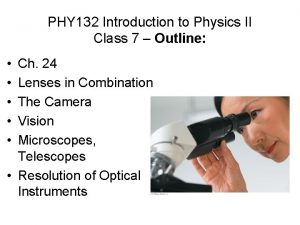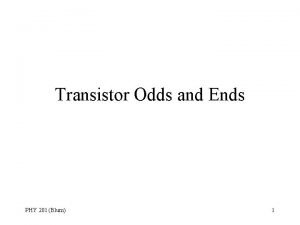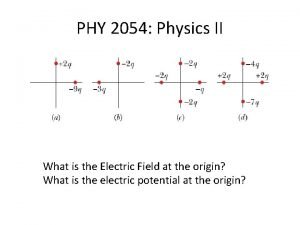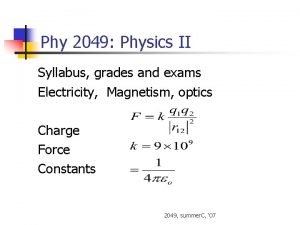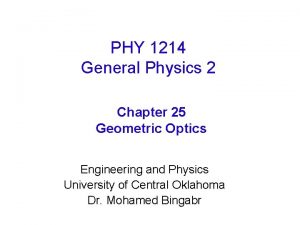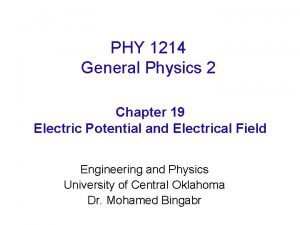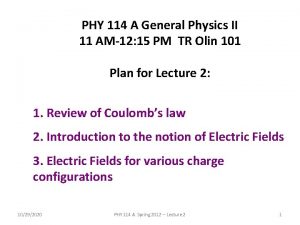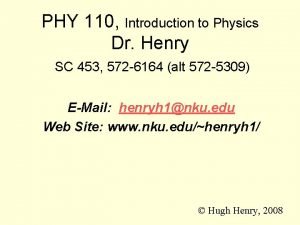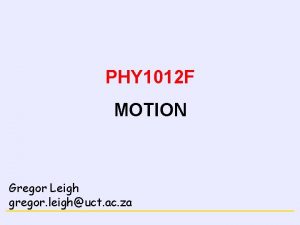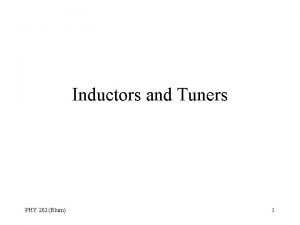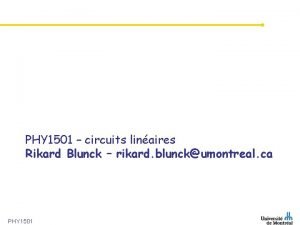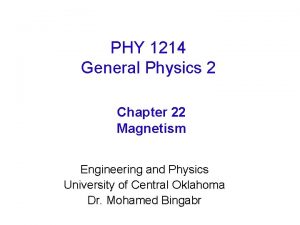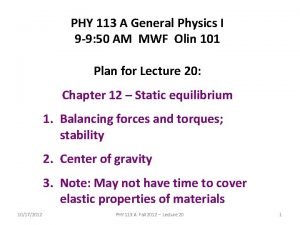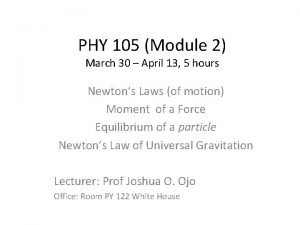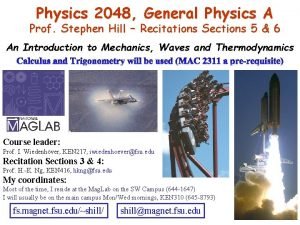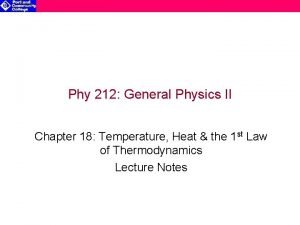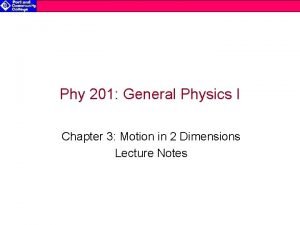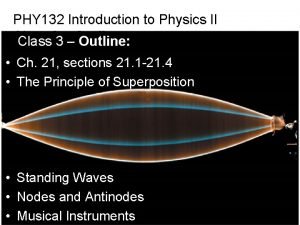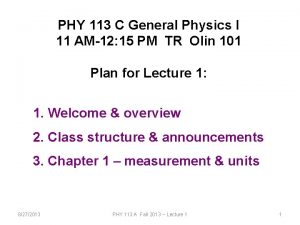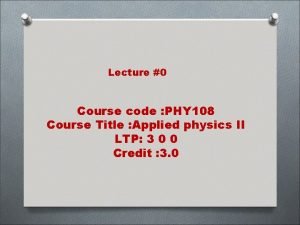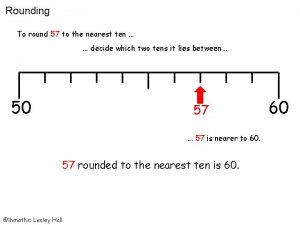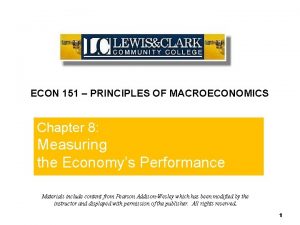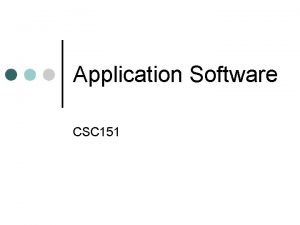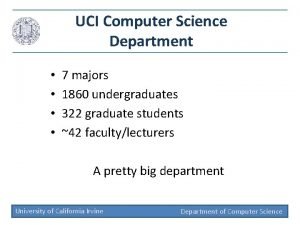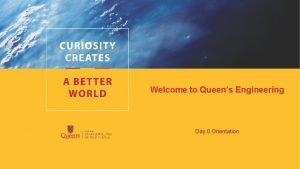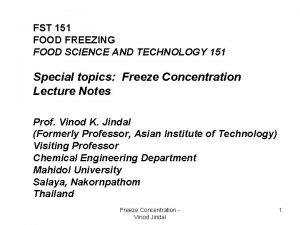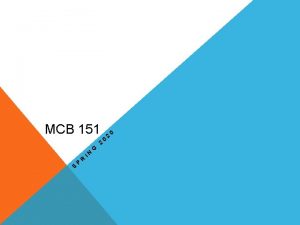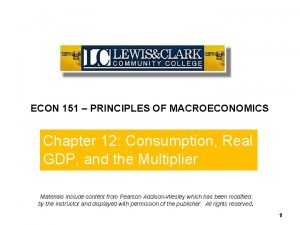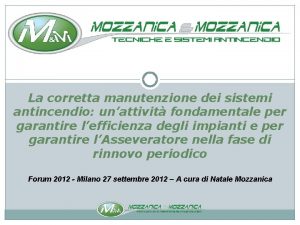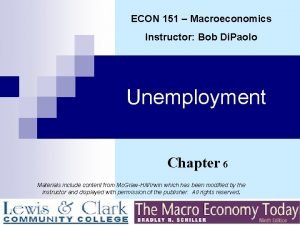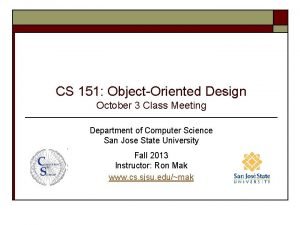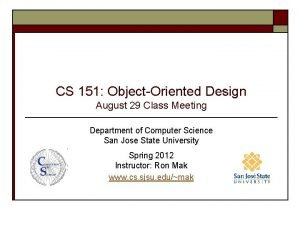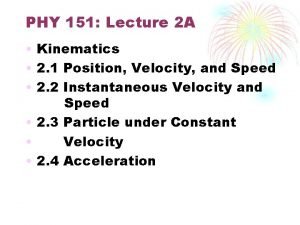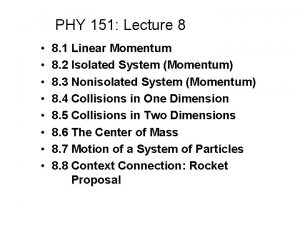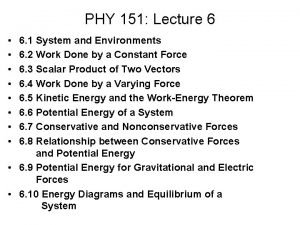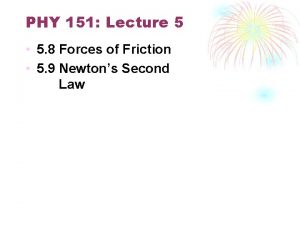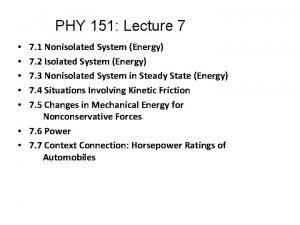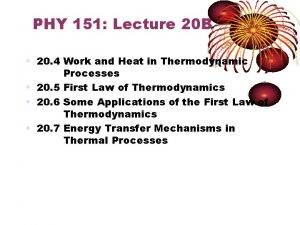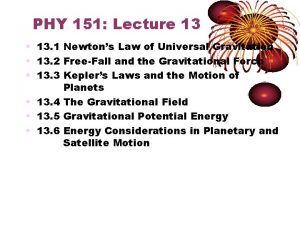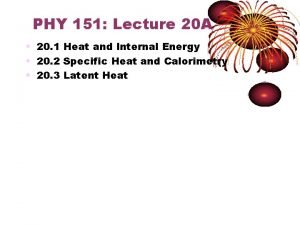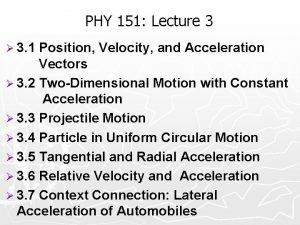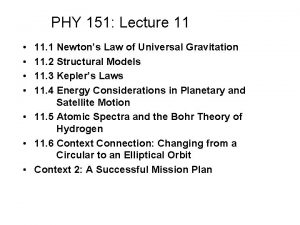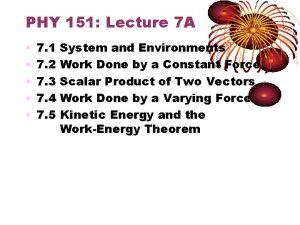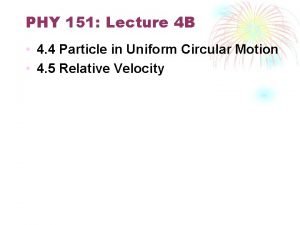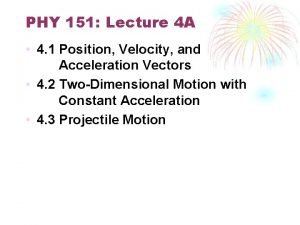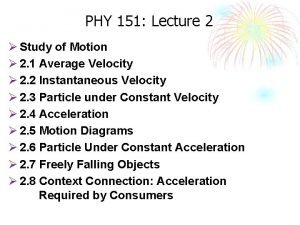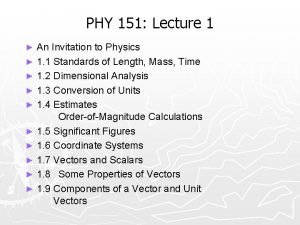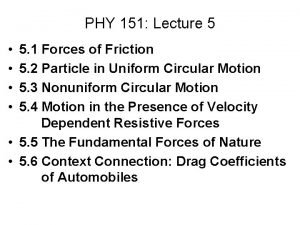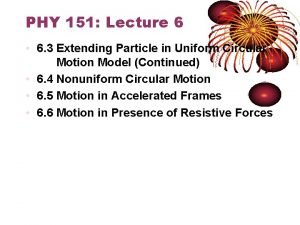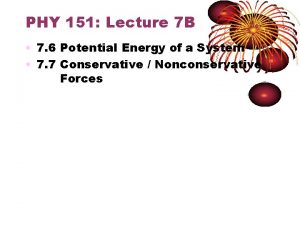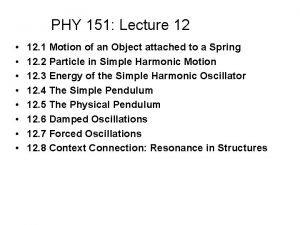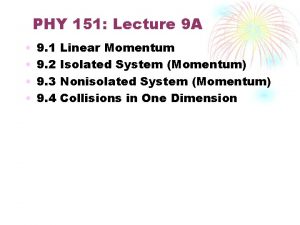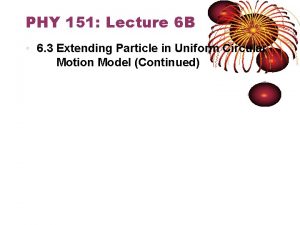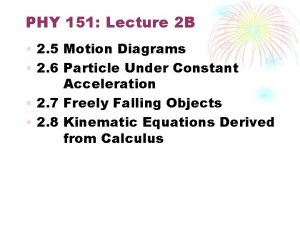PHY 151 Lecture 4 Dynamics History 4 1








































































- Slides: 72

PHY 151: Lecture 4 Ø Dynamics History Ø 4. 1 The Concept of Force Ø 4. 2 Newton’s First Law Ø 4. 3 Mass Ø 4. 4 Newton’s Second Law Ø 4. 5 Gravitational Force and Weight Ø 4. 6 Newton’s Third Law Ø 4. 7 Using Newton’s Second Law

PHY 151: Lecture 4 The Laws of Motion Dynamics History

Dynamics History - 1 • Aristotle (384 BC to 322 BC) • Observed nature, philosophized about nature, did no experiments • Natural Motion (sub-lunar) – Elements earth, air, water, and fire seek their natural place – Earth / water move straight down, air / fire move straight up • Natural Motion (supralunar) – Heavenly bodies are made from a fifth element, quintessence – The natural state is circular motion • Violent Motion – Objects are moved by force • The normal state of motion on earth is rest • Heavy objects have a greater desire to reach their natural place than light objects and therefore fall faster • Speed of fall depends inversely on density of medium it falls through • No vacuum, because object would move through it with infinite speed • These statements accepted in Europe for nearly 2, 000 years

Dynamics History - 2 • • Beginning with Medieval Europe and continuing into the Renaissance, some Europeans and Muslims made contributions to dynamics Abu Sahl al-Quhi (Kuhi) (1000) – Discovers that heaviness of bodies vary with their distance from center of Earth Ibn al-Haytham (1000 – 1037) – Discusses theory of attraction between masses – Seems that he was aware of the magnitude of acceleration due to gravity – Discovered the law of inertia, known as Newton's first law of motion, when he stated that a body moves perpetually unless an external force stops it or changes its direction of motion Avicenna (1000 -1037) – Father of the fundamental concept of momentum in physics – Discovered the concept of momentum, when he referred to impetus as being proportional to weight times velocity, a precursor to the concept of momentum in Newton's second law of motion – His theory of motion was also consistent with the concept of inertia in Newton's first law of motion

Dynamics History – 3 • • • Abu Rayhan al-Biruni (1000 – 1048) – Was the first to realize that acceleration is connected with nonuniform motion Ibn Bajjah (Avempace) (1100 – 1138) – First to state that there is always a reaction force for every force exerted – Precursor to Gottfried Leibniz's idea of force which underlies Newton's third law of motion – His theory of motion later has an important influence on later physicists like Galileo Galilei Hibat Allah Abu'l-Barakat al-Baghdaadi (1100 – 1165) – Writes a critique of Aristotelian philosophy and Aristotelian physics – First to negate Aristotle's idea that a constant force produces uniform motion, as he realizes that a force applied continuously produces acceleration, which is considered "the fundamental law of classical mechanics" and an early foreshadowing of Newton's second law of motion – Like Newton, he described acceleration as the rate of change of velocity

Dynamics History – 4 • Al-Khazini (1121) – Publishes The Book of the Balance of Wisdom, in which he is the first to propose that the gravity and gravitational potential energy of a body varies depending on its distance from the center of the Earth – This phenomenon is not proven until Newton's law of universal gravitation – One of the first to clearly differentiate between force, mass, and weight – He and his Muslim predecessors unified statics and dynamics into the science of mechanics – The contributions of al-Khazini and his Muslim predecessors to mechanics laid the foundations for the later development of classical mechanics in Renaissance Europe

Dynamics History – 5 • Jean Boridan (1355) – The concept of inertia was alien to the physics of Aristotle – Aristotle held that a body was only maintained in motion by the action of a continuous external force – In the Aristotelian view, a projectile moving through the air owed its continuing motion to eddies or vibrations in the surrounding medium – Jean Buridan proposed that motion was maintained by some property of the body, imparted when it was set in motion – Buridan named the motion-maintaining property impetus – He rejected the view that the impetus dissipated spontaneously asserting that a body would be arrested by the forces of air resistance and gravity which might be opposing its impetus – Buridan further held that the impetus of a body increased with the speed with which it was set in motion, and with its quantity of matter – Buridan's impetus is related to the modern concept of momentum – Buridan saw impetus as causing the motion of the object – Buridan anticipated Isaac Newton when he wrote: • . . . after leaving the arm of the thrower, the projectile would be moved by an impetus given to it by the thrower and would continue to be moved as long as the impetus remained stronger than the resistance, and would be of infinite duration were it not diminished and corrupted by a contrary force resisting it or by something inclining it to a contrary motion

Dynamics History – 6 • Niccolo Tartaglia (1537) – First to apply mathematics to the investigation of the paths of cannonballs – His work was later validated by Galileo’s studies on falling bodies • Giambattista Benedetti (1553) – Benedetti proposed a new doctrine of the speed of bodies in free fall – The accepted Aristotelian doctrine at that time was that the speed of a freely falling body is directly proportional to the total weight of the body and inversely proportional to the density of the medium – As opposed to the Aristotelian theory, his theory predicts that two objects of the same material but of different weights would fall at the same speed, and also that objects of different materials in a vacuum would fall at different though finite speeds – In a second edition of the Demonstratio (1554), he extended this theory to include the effect of the resistance of the medium, which he said was proportional to the cross section or the surface area of the body – Two objects of the same material but of different surface areas would only fall at equal speeds in a vacuum – It is thought that Galileo derived his initial theory of the speed of a freely falling body from his reading of Benedetti's works – The account found in Galileo's De motu, his early work on the science of motion, follows Benedetti's initial theory as described above – In this early work, Galileo also subscribes to theory of impetus

Dynamics History - 7 • Giovanni Benedetti (1553, 1585) – He stated that bodies composed of the same material fell at the same speed regardless of their weight – At this time Aristotle’s views were accepted without question – What Benedetti was putting forward was in complete contradiction to Aristotle – Those who read Benedetti's work did not accept his ideas – Some argued that his idea was stupid – Other agreed with his findings but said that they must be in agreement with Aristotle – Benedetti himself remarks that he had critics in Rome who said that Aristotle was always right, so his work must be wrong • Simon Stevin (1586) – Demonstrated that two objects of different weight fall down with exactly the same acceleration

Dynamics History - 8 • • Galileo Galilei (1564 – 1642) Used reasoning, thought experiments and actual experiments Mostly developed kinematics Developed concept of acceleration Falling objects accelerate uniformly, and fall with the same speed Air retards falling objects such as a feather Distance traveled by objects under uniform acceleration increases by t 2 • Motion of a projectile falling freely under gravity is compound consisting of uniform motion horizontally and uniform accelerating motion vertically • Law of Inertia: – Objects want to move in a straight line with constant velocity – Objects don’t stop moving when the force is removed – Friction force stops motion – Unbalanced forces keep objects from moving in a straight line with constant velocity

Dynamics History - 9 • Isaac Newton (1643 – 1727) – Law of Gravity – Laws of Motion – Established modern study of optics – First reflecting telescope – Invented Calculus – Alchemy

PHY 151: Lecture 4 The Laws of Motion 4. 1 The Concept of Force

The Concept of Force -1 • Contact forces involve physical contact between two objects (a, b, c) • Field forces act through empty space (d, e , f) • No physical contact is required

The Concept of Force -2 • A spring can be used to calibrate the magnitude of a force • Forces are vectors, so you must use the rules for vector addition to find the net force acting on an object

The Concept of Force -3

The Concept of Force - 4 • Gravitational force – Between objects • Electromagnetic forces – Between electric charges • Nuclear force – Between subatomic particles • Weak forces – Arise in certain radioactive decay processes • Note: These are all field forces

The Concept of Force - 5 • In the course we will consider five forces ØGravity ØElectromagnetism • • Normal Friction Tension Push / Pull

PHY 151: Lecture 4 The Laws of Motion 4. 2 Newton’s First Law

Newton’s First Law - 1 • If an object does not interact with other objects, it is possible to identify a reference frame in which the object has zero acceleration • This is also called the law of inertia • It defines a special set of reference frames called inertial frames • We call this an inertial frame of reference

Newton’s First Law – 2 • Any reference frame that moves with constant velocity relative to an inertial frame is itself an inertial frame • A reference frame that moves with constant velocity relative to the distant stars is the best approximation of an inertial frame • We can consider the Earth to be such an inertial frame although it has a small centripetal acceleration associated with its motion

Newton’s First Law - 3 • In the absence of external forces, when viewed from an inertial reference frame, an object at rest remains at rest and an object in motion continues in motion with a constant velocity – Newton’s first law describes what happens in the absence of a force – It also tells us that when no force acts on an object, the acceleration of the object is zero

Newton’s First Law - 4 • The tendency of an object to resist any attempt to change its velocity is called inertia • Mass is that property of an object that specifies how much resistance an object exhibits to changes in its velocity

Newton’s First Law - 5 • Two observers, one on the ground (G) and the other on a train (T). • Imagine that you place a puck on a perfectly level air hockey table. • You expect that the puck will remain stationary when it is placed gently at rest on the table. • Now imagine putting your air hockey table on a train moving with constant velocity. • If the puck is placed on the table, the puck again remains where it is placed. • The observer is in an inertial frame of reference.

Newton’s First Law - 6 • When the puck is on the air hockey table on the ground, you are observing (G) it from an inertial reference frame; there are no horizontal interactions of the puck with any other objects, and you observe it to have zero acceleration in the horizontal direction. • When you are on a train moving at constant velocity, you are also observing (T) the puck from an inertial reference frame. • Any reference frame that moves with constant velocity relative to an inertial frame is itself an inertial frame.

Newton’s First Law - 7 • When the train accelerates, however, you are observing (T) the puck from a noninertial reference frame because you and the train are accelerating relative to the inertial reference frame of the surface of the earth. • Although the puck appears to be accelerating according to your observations, we can identify a reference frame in which the puck has zero acceleration.

Newton’s First Law - 8 • For example, an observer (G) standing outside the train on the ground sees the puck sliding relative to the table but always moving with the same velocity with respect to the ground as the train had before it started to accelerate (because there is almost no friction to “tie” the puck and train together. ) • Therefore, Newton’s first law is still satisfied even though your observers say otherwise.

Newton’s First Law – 9 • • • Rocket is in deep space No gravity No air inside rocket A ball is at top of rocket Rocket begins to accelerate up Observer outside rocket

Newton’s First Law - 10 • Outside rocket observer sees: – the rocket accelerate up – the ball not moving – no force on the ball • Outside observer sees that Newton’s First Law is obeyed • Outside observer is in an inertial frame of reference Observer outside rocket

Newton’s First Law - 11 • Astronaut sees: – the ball accelerate towards the bottom of rocket – no force on the ball • Ball is accelerating with no force • Newton’s First Law is not obeyed • Astronaut must believe that a new fictitious force has suddenly been turned on Observer outside rocket

Newton’s First Law - 12 • A frame of reference that is accelerating relative to an inertial frame of reference is a non-inertial frame of reference • In a non-inertial frame of reference, Newton’s First Law is not obeyed unless a fictitious force is assumed Observer outside rocket

PHY 151: Lecture 4 The Laws of Motion 4. 3 Mass

Mass - 1 • Mass is an inherent property of an object – It is independent of the object’s surroundings • Mass is independent of the method used to measure it – Mass is a scalar quantity – The SI unit of mass is kg

Mass - 2 • Mass and weight are two different quantities • Weight is equal to the magnitude of the gravitational force exerted on the object • Weight will vary with location • The mass of an object is the same everywhere

PHY 151: Lecture 4 The Laws of Motion 4. 4 Newton’s Second Law

Newton’s Second Law – 1 • The acceleration of an object is directly proportional to the net force acting on it and inversely proportional to its mass • Force is the cause of change in motion, as measured by the acceleration • In equation form: where S means the sum

Newton’s Second Law – 2 • Newton’s second law can be expressed in terms of components: • The analysis model used in conjunction with Newton’s second law is the particle under a net force

Newton’s Second Law – 3 • SI unit of force is newton: 1 N = 1 kg·m/s 2

Newton’s Second Law - 4 • Newton’s Statement of the Law – A measure of motion is momentum = p = mv – The greater the “motion” the greater is mv – Rate of change of momentum = SF – SF = Dp/Dt = D(mv)/Dt = [(mv)f – (mv)i]/Dt – When viewed from an inertial reference frame – Force, momentum and velocity are vectors – SF means sum of external forces

Newton’s Second Law - 5 • Contemporary Statement of the Law – Mass does not change, then – SF = Dp/Dt = D(mv)/Dt = m. Dv/Dt = ma – SF = ma

Example 4. 1

Example 4. 1 • Find the component of the net force acting on the puck in the x direction: • Find the component of the net force acting on the puck in the y direction:

Example 4. 1 • Find the magnitude of the acceleration: • Find the direction of the acceleration relative to the positive x axis:

PHY 151: Lecture 4 The Laws of Motion 4. 5 The Gravitational Force and Weight

The Gravitational Force and Weight - 1 • This force is directed toward the center of the Earth • Its magnitude is called the weight of the object Weight = Fg = mg • Because it is dependent on g, the weight varies with location • g, and therefore the weight, is less at higher altitudes

The Gravitational Force and Weight – 2 • In Newton’s Laws, the mass is the inertial mass and measures the resistance to a change in the object’s motion • In the gravitational force, the mass is determining the gravitational attraction between the object and the Earth – Experiments show that gravitational mass and inertial mass have the same value

PHY 151: Lecture 4 The Laws of Motion 4. 6 Newton’s Third Law

Newton’s Third Law - 1 • Newton’s third law states:

Newton’s Third Law – 2 • Forces always occur in pairs – A single isolated force cannot exist • The action force is equal in magnitude to the reaction force and opposite in direction – One of the forces is the action force, the other is the reaction force – It doesn’t matter which is considered the action and which the reaction – The action and reaction forces must act on different objects and be of the same type

Newton’s Third Law - 3

Newton’s Third Law - 4

Newton’s Third Law - 5

Newton’s Third Law - 6 • The normal force and the force of gravity are the forces that act on the monitor • In a free-body diagram, you want the forces acting on a particular object • Let the object be a represented by a point

PHY 151: Lecture 4 The Laws of Motion 4. 7 Using Newton’s Second Law

Using Newton’s Second Law – 1 Particle in Equilibrium • Objects at rest or moving with constant velocity are in equilibrium • The vector sum of all forces (net force) acting on an object is zero • In terms of components:

Using Newton’s Second Law – 2 Particle Under a Net Force • If an object experiences an acceleration: • Consider a crate being pulled to the right:

Using Newton’s Second Law – 3 • Free-body diagram of crate: – Normal force – Tension force – Gravitational force • Apply Newton’s second law:

Example 4. 2 • A traffic light weighing 122 N hangs from a cable tied to two other cables fastened to a support. The upper cables make angles of 37. 0 and 53. 0 with the horizontal. These upper cables are not as strong as the vertical cable and will break if the tension in them exceeds 100 N. Does the traffic light remain hanging in this situation, or will one of the cables break?

Example 4. 2 – Apply Newton’s second law to the traffic light in the y direction: – Resolve forces acting on the knot into their components:

Example 4. 2 – Apply the particle in equilibrium model to the knot: – Solve Equation (1) for T 2 in terms of T 1: – Substitute into Equation (2) • Both values are less than 100 N, so cables won’t break

Example 4. 3 A car of mass m is on an icy driveway inclined at an angle .

Example 4. 3 (A) Find the acceleration of the car, assuming the driveway is frictionless. – Apply Newton’s second law in component form: – Solve for ax:

Example 4. 3 (B) Suppose the car is released from rest at the top of the incline and the distance from the car’s front bumper to the bottom of the incline is d. How long does it take the front bumper to reach the bottom of the hill, and what is the car’s speed as it arrives there?

Example 4. 3 – Use d = ½axt 2 and solve for t: – Use vxf 2 = 2 a x xd to find velocity:

Example 4. 4 When two objects of unequal mass are hung vertically over a frictionless pulley of negligible mass, the arrangement is called an Atwood machine. The device is sometimes used in the laboratory to determine the value of g. Determine the magnitude of the acceleration of the two objects and the tension in the lightweight string.

Example 4. 4 •

Example 4. 4 • Solve for the acceleration: • Substitute Equation (3) into Equation (1):

Example 4. 5 Two blocks of masses m 1 and m 2, with m 1 > m 2, are placed in contact with each other on a frictionless, horizontal surface. A constant horizontal force is applied to m 1.

Example 4. 5 (A) Find the magnitude of the acceleration of the system. • Model the combination of two blocks as a single particle under a net force, and apply Newton's second law in the x direction:

Example 4. 5 (B) Determine the magnitude of the contact force between the two blocks. – Construct free-body diagrams of each block – Apply Newton’s second law to m 2: – Substitute the acceleration found in (A) into Equation (2):

Example 4. 6 A person weighs a fish of mass m on a spring scale attached to the ceiling of an elevator.

Example 4. 6 (A) Show that if the elevator accelerates either upward or downward, the spring scale gives a reading that is different from the weight of the fish. – Apply Newton’s second law to the fish: – Solve for T:

Example 4. 6 (B) Evaluate the scale readings for a 40. 0 -N fish, if the elevator moves with an acceleration ay = 62. 00 m/s 2. • Evaluate for upward acceleration: • Evaluate for downward acceleration:
 Nearsightedness physics
Nearsightedness physics 01:640:244 lecture notes - lecture 15: plat, idah, farad
01:640:244 lecture notes - lecture 15: plat, idah, farad Power system dynamics and stability lecture notes
Power system dynamics and stability lecture notes Power system dynamics and stability lecture notes
Power system dynamics and stability lecture notes Phy 131 past papers
Phy 131 past papers Pa msu
Pa msu The great orthogonality theorem
The great orthogonality theorem Rotational statics
Rotational statics Phy theorem
Phy theorem Phy113
Phy113 Phy 121 asu
Phy 121 asu Ddr phy architecture
Ddr phy architecture Phy 205
Phy 205 Site:slidetodoc.com
Site:slidetodoc.com Phy 2049
Phy 2049 Physics 2
Physics 2 Phy
Phy Phy
Phy Atm packet phy
Atm packet phy Phy
Phy Phy 2049
Phy 2049 General physics
General physics Phy 1214
Phy 1214 Phy
Phy Phy 110
Phy 110 Complete motion diagram
Complete motion diagram Phy
Phy Life phy
Life phy Phy1501
Phy1501 Phy 1214
Phy 1214 2012 phy
2012 phy Phy-105 5 discussion
Phy-105 5 discussion Phy 2048c fsu
Phy 2048c fsu Examples of convection
Examples of convection General physics chapters
General physics chapters Phy 1214
Phy 1214 Phy 132
Phy 132 Phy 1214
Phy 1214 Phy108
Phy108 Phy tgen
Phy tgen How to round off 25
How to round off 25 Chemistry 151 final exam
Chemistry 151 final exam Main event management
Main event management Conforme a tua infinita graça numero
Conforme a tua infinita graça numero Econ 151
Econ 151 Mass produced copyrighted retail software
Mass produced copyrighted retail software 118/151
118/151 Business information management uci
Business information management uci Tổng kết vốn từ 151
Tổng kết vốn từ 151 Immurel
Immurel Aphra rogers
Aphra rogers 1,151,725 bytes
1,151,725 bytes Freeze concentration
Freeze concentration Mcb 317 uiuc
Mcb 317 uiuc Determinants of consumption
Determinants of consumption Scia antincendio esempio
Scia antincendio esempio Econ 151
Econ 151 Sjsu cs 151
Sjsu cs 151 Cs 151 sjsu
Cs 151 sjsu History also history physical
History also history physical Project procurement management lecture notes
Project procurement management lecture notes Lecture about sport
Lecture about sport Healthy lifestyle wrap up lecture
Healthy lifestyle wrap up lecture Makeup lecture meaning
Makeup lecture meaning Meaning of this
Meaning of this Randy pausch last lecture summary
Randy pausch last lecture summary Tensorflow lecture
Tensorflow lecture Theology proper lecture notes
Theology proper lecture notes Strategic management lecture
Strategic management lecture Geology lecture series
Geology lecture series Social psychology lecture
Social psychology lecture In text citation for a lecture
In text citation for a lecture Objective of public sector accounting
Objective of public sector accounting
